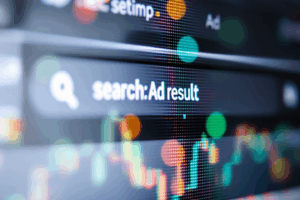
Lose vs. Loose: A Guide to Remembering the Difference
Common English Errors Blogs “Let’s Learn, Explore, and Connect to the World” Lose vs. Loose: A Guide to Remembering the Difference Introduction Few word pairs




Think of digital marketing as using the internet to tell people about your products or services. It’s like being able to speak to the whole world about what you do, using tools like social media, websites, and emails. As more people spend time online, it’s important for businesses to reach out to them where they are.
Digital marketing has changed a lot because of new technology and how people behave online. It started with simple ads and emails but now includes getting your website to show up in search results, sharing interesting stories and information on social media, and understanding what people do online to improve marketing.
Those in the business of selling, digital marketing helps you tell your story in a way that your audience will like. It’s about making connections, building trust, and keeping those relationships over time. With the right online tools, you can reach more people than ever before and grow your business.
Digital marketing is like a big puzzle, with each piece playing a special role. Here’s a simple way to look at it:

This isn’t just about creating advertisements; it’s about making something valuable like blog posts, videos, or infographics that capture people’s interest. Imagine you’re a chef. Instead of just telling people to visit your restaurant, you share your secret recipes or cooking tips through a series of blog posts. This way, you’re not directly selling anything, but those who enjoy your content will likely be interested in tasting your cooking. It’s about drawing people in with your expertise and passions, turning viewers into fans, and fans into customers. Regularly updating your blog or social media with fresh, relevant content keeps your audience engaged and helps establish your authority in your field. For instance, if you run a gardening store, posting how-to guides on planting seasonal flowers or creating a butterfly garden can attract enthusiasts to your site, making them more inclined to buy from you. Bringing all these pieces together makes your marketing strategy stronger. It’s like hosting a party, telling great stories, and making sure people can find your house to join the fun.

Think of the internet as a massive library and your website as one book among millions. SEO is like the library’s index system designed to help people find your book. It involves using the right keywords that people type into search engines when looking for information. For example, if you sell eco-friendly water bottles, you want to appear when someone searches for “environmentally friendly drinking solutions.” To do this, you include phrases like “eco-friendly water bottles” in your website’s text, especially in strategic places like titles and headings. But it’s not just about keywords; making your website easy to navigate and ensuring it loads quickly is also important. It’s like making sure your book not only has the right title and summary but is also easy to reach and open in the library.

While SEO focuses on naturally appearing in search results, SEM involves paying for a top spot. Imagine you’re competing in a talent show where the order of performance is decided by drawing lots. With SEM, you’re essentially paying to perform first, ensuring the audience sees you before anyone else. This is crucial when you’re launching a new product or have a special offer that you want to get in front of as many eyes as possible, quickly. For example, if you’re selling concert tickets that are about to go on sale, using SEM can put your website at the top of search results when people search for “live music events” or “concert tickets,” increasing the chances of selling out.

This involves using social platforms like Facebook, Instagram, and Twitter not just to post updates, but to genuinely connect with your audience. It’s like hosting a virtual party where you get to chat with your guests, share stories, and listen to their experiences. For example, if you own a pet store, you can share cute photos of pets, ask followers to post pictures with their furry friends and offer tips on pet care. This helps build a community around your brand. You can also use these platforms for customer service, answering questions, and addressing concerns in real-time, which adds a personal touch to your business. It’s about creating an environment where your audience feels valued and engaged.

One of the oldest forms of digital marketing, email marketing is far from obsolete. It’s like sending a personalized letter to each of your customers. You can use it to update them on new products, offer discounts, or simply share news about your industry. For example, if you run a bookstore, you can send monthly newsletters highlighting the latest arrivals, upcoming author events, or book club meetings. The key is to make these emails informative and valuable, so your subscribers are happy to see them in their inbox. Personalization, such as including the recipient’s name and tailoring the content based on their preferences (like suggesting sci-fi books to a sci-fi fan), can significantly increase engagement.
Bringing these elements together in a coherent and consistent manner amplifies the strength of your digital marketing strategy. It’s about creating a vibrant, welcoming space (your digital presence) where people want to visit and return, much like being a great host who throws memorable parties.

Imagine you’re at a party and want to tell an interesting story. Content marketing is just that, but online. You create stories and information that are so interesting, that people want to come back for more.
For example, if you sell plants, you could write blog posts about the best plants for beginners or make a video on how to care for succulents. The idea is to share stuff that’s helpful and fun, not just about selling.
To do this well, think about what your audience likes, plan your stories, and keep sharing regularly. Watching what works and what doesn’t will help you get better over time.
Imagine you’ve written a fantastic story or developed an exciting new product, and now you want the world to know about it. Your challenge is ensuring that people can find your story amidst the vast ocean of information online. This is where SEO and SEM become your best tools.
 SEO (Search Engine Optimization) is like crafting a series of signposts that guide people to your story. It involves carefully selecting the words (keywords) that people are likely to use when searching for topics related to your story or product. For example, if you’ve written a guide on how to grow indoor plants, you’d want to include phrases like “indoor gardening tips” or “best plants for indoors” on your website. But it’s not just about keywords; making your site user-friendly, with fast loading times and mobile compatibility, also plays a huge part in SEO. It’s a long-term strategy that, when done right, builds your visibility over time, attracting a steady stream of visitors to your site organically.
SEO (Search Engine Optimization) is like crafting a series of signposts that guide people to your story. It involves carefully selecting the words (keywords) that people are likely to use when searching for topics related to your story or product. For example, if you’ve written a guide on how to grow indoor plants, you’d want to include phrases like “indoor gardening tips” or “best plants for indoors” on your website. But it’s not just about keywords; making your site user-friendly, with fast loading times and mobile compatibility, also plays a huge part in SEO. It’s a long-term strategy that, when done right, builds your visibility over time, attracting a steady stream of visitors to your site organically.
 SEM (Search Engine Marketing), on the other hand, is like renting a giant billboard on the busiest highway in town. You pay for a prime spot in search engine results, ensuring that your story or product is one of the first things people see when they’re searching for related topics. This method is especially useful for announcements, promotions, or when you’re entering a new market and need immediate exposure. It’s a quick, targeted way to boost your visibility and direct traffic to your site, complementing your SEO efforts.
SEM (Search Engine Marketing), on the other hand, is like renting a giant billboard on the busiest highway in town. You pay for a prime spot in search engine results, ensuring that your story or product is one of the first things people see when they’re searching for related topics. This method is especially useful for announcements, promotions, or when you’re entering a new market and need immediate exposure. It’s a quick, targeted way to boost your visibility and direct traffic to your site, complementing your SEO efforts.
 Both SEO and SEM are crucial for building your online presence. SEO lays the groundwork for sustained growth, helping you climb the ranks in search results over time, while SEM gives you a quick visibility boost when you need it most. Together, they ensure that whether people are leisurely browsing or actively searching, your story gets the audience it deserves.
Both SEO and SEM are crucial for building your online presence. SEO lays the groundwork for sustained growth, helping you climb the ranks in search results over time, while SEM gives you a quick visibility boost when you need it most. Together, they ensure that whether people are leisurely browsing or actively searching, your story gets the audience it deserves.
By investing in both SEO and SEM, you’re essentially setting up both permanent signposts and eye-catching billboards, guiding more and more people to discover your story, engage with your brand, and join the journey you’re on. It’s a powerful combination that can significantly enhance your web visibility and bring your message to the forefront where it belongs.
 Social media is your digital megaphone and listening device, all rolled into one. It’s a dynamic space where you can showcase what makes your business or personal brand unique and tune into the feedback and interests of your audience. The key to making the most of this space lies not just in what you say, but also in where and how you engage your audience.
Social media is your digital megaphone and listening device, all rolled into one. It’s a dynamic space where you can showcase what makes your business or personal brand unique and tune into the feedback and interests of your audience. The key to making the most of this space lies not just in what you say, but also in where and how you engage your audience.
 Choosing the right platform is crucial. Imagine social media platforms as different types of gatherings. Instagram and Facebook are like casual meetups where visuals take center stage, perfect for sharing behind-the-scenes looks, stories, and photos that highlight your brand’s personality and values. LinkedIn is the industry conference room, ideal for sharing your professional achievements, and insights, and connecting with industry peers. Twitter acts as the bustling city square, where news breaks, trends emerge, and conversations happen in real-time. Each platform serves a unique purpose in your social media strategy, catering to different aspects of your professional persona and audience.
Choosing the right platform is crucial. Imagine social media platforms as different types of gatherings. Instagram and Facebook are like casual meetups where visuals take center stage, perfect for sharing behind-the-scenes looks, stories, and photos that highlight your brand’s personality and values. LinkedIn is the industry conference room, ideal for sharing your professional achievements, and insights, and connecting with industry peers. Twitter acts as the bustling city square, where news breaks, trends emerge, and conversations happen in real-time. Each platform serves a unique purpose in your social media strategy, catering to different aspects of your professional persona and audience.
 The magic of social media lies in interaction. It’s not just about broadcasting your message but engaging in a two-way conversation. Encourage this dialogue by asking your followers questions, creating polls, and responding to comments and messages. Share interesting facts, tips, and insights related to your field to position yourself as a go-to resource. Visual content, like photos and videos, is crucial for grabbing interest and getting your message across message more effectively.
The magic of social media lies in interaction. It’s not just about broadcasting your message but engaging in a two-way conversation. Encourage this dialogue by asking your followers questions, creating polls, and responding to comments and messages. Share interesting facts, tips, and insights related to your field to position yourself as a go-to resource. Visual content, like photos and videos, is crucial for grabbing interest and getting your message across message more effectively.
Remember, consistency is key. Regularly updating your profiles and staying active maintains audience interest and cultivates a dedicated following community around your brand. By strategically leveraging different social media platforms and fostering genuine interactions, you can significantly enhance your professional growth and establish a strong, engaging online presence.
 In the digital marketing world, analytics act like your personal detective, uncovering the mysteries of what your audience loves, interacts with, or glosses over. It’s akin to having a feedback loop at every party you host, knowing exactly which dishes were hits and which were misses. Analytics tools dig into the depths of your online activities, from social media posts to email campaigns, providing a clear picture of your successes and areas for improvement.
In the digital marketing world, analytics act like your personal detective, uncovering the mysteries of what your audience loves, interacts with, or glosses over. It’s akin to having a feedback loop at every party you host, knowing exactly which dishes were hits and which were misses. Analytics tools dig into the depths of your online activities, from social media posts to email campaigns, providing a clear picture of your successes and areas for improvement.
 The journey towards achievement begins with establishing well-defined and trackable goals. Whether you aim to increase your website traffic, boost the number of subscribers to your newsletter, or elevate engagement rates on social media, these targets give you something concrete to strive toward. Imagine setting a goal to increase the number of visitors to your new blog by 30% within three months. Analytics tools enable you to track your weekly progress toward this goal, offering insights into which promotional strategies are drawing in the crowd and which are not.
The journey towards achievement begins with establishing well-defined and trackable goals. Whether you aim to increase your website traffic, boost the number of subscribers to your newsletter, or elevate engagement rates on social media, these targets give you something concrete to strive toward. Imagine setting a goal to increase the number of visitors to your new blog by 30% within three months. Analytics tools enable you to track your weekly progress toward this goal, offering insights into which promotional strategies are drawing in the crowd and which are not.
Regularly monitoring these metrics allows for agile adjustments. Perhaps a series of blog posts on a trending topic brings a surge in new visitors, or an email subject line tweak leads to higher open rates. Analytics provides this invaluable feedback, acting as a compass to guide your digital marketing efforts.
 Experimentation is another critical aspect illuminated by analytics. By conducting A/B tests—comparing two versions of a webpage, ad, or email—you can see firsthand what resonates with your audience. Maybe changing the color of a call-to-action button increases click-through rates, or a more casual tone in your emails fosters greater engagement. These insights help refine your strategies, ensuring they’re aligned with your audience’s preferences and behaviors.
Experimentation is another critical aspect illuminated by analytics. By conducting A/B tests—comparing two versions of a webpage, ad, or email—you can see firsthand what resonates with your audience. Maybe changing the color of a call-to-action button increases click-through rates, or a more casual tone in your emails fosters greater engagement. These insights help refine your strategies, ensuring they’re aligned with your audience’s preferences and behaviors.
In essence, analytics transforms guesswork into strategy, offering a data-driven pathway to achieving your digital marketing goals. It’s about listening to the virtual room, adjusting the playlist based on what gets people moving, and ultimately hosting the party everyone talks about.
 Getting good at digital marketing is like learning to host the best parties. You need great stories (content marketing), signs to guide people (SEO), an invite (SEM), conversations (social media), personal letters (email), and a way to know what works (analytics). Each part adds to the fun and helps you connect with more people.
Getting good at digital marketing is like learning to host the best parties. You need great stories (content marketing), signs to guide people (SEO), an invite (SEM), conversations (social media), personal letters (email), and a way to know what works (analytics). Each part adds to the fun and helps you connect with more people.
The world of digital marketing is always changing, so keep learning, be creative, and adapt. That’s how you’ll grow your brand and keep your audience coming back for more.

Common English Errors Blogs “Let’s Learn, Explore, and Connect to the World” Lose vs. Loose: A Guide to Remembering the Difference Introduction Few word pairs

English Blogs “Let’s Learn, Explore, and Connect to the World” Present Simple Continuous 1 I. Introduction to the Present Continuous Tense in English The present

Discover your inner editing abilities with this complete guide made for beginners to master the art of video editing smoothly. ‘A Beginner’s Guide to Video Editing: Be a Pro in Just 24 Hours’ is your way to discover the secrets of professional-grade editing within a day.



